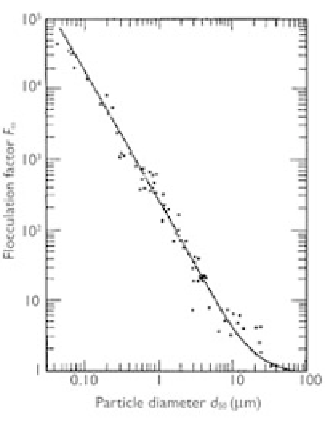Geoscience Reference
In-Depth Information
11.1.2 Factors affecting flocculation
Flocculation of cohesive sediment particles is affected by sediment size, sediment
concentration, salinity, turbulence intensity, temperature, organic matters, etc.
Sediment size
Experiments have shown that flocculation is negligible for sediment particles larger
than about 0.03 mm, but it becomes stronger as sediment size reduces. Migniot (1968)
defined a flocculation factor as
F
ω
=
ω
sf
/ω
sd
, in which
ω
sd
are the median
settling velocities of flocs and the corresponding dispersed sediment particles, respec-
tively. Migniot measured
ω
sf
and
ω
sd
in a settling column using a large number of
muddy sediment samples with different compositions at a sediment concentration of
10 kg
ω
sf
and
m
−
3
and a salinity of 30 ppt. As shown in Fig. 11.4, the flocculation factor
F
ω
varies with the median size
d
50
of the dispersed sediment according to
·
d
r
d
50
n
d
F
ω
=
(11.1)
where
n
d
=
1.8, and
d
r
is a reference diameter, about 0.0215 mm.
Figure 11.4
Flocculation factor
F
ω
as function of particle
d
50
(Migniot, 1968).
Qian (1980), Huang (1981), and Dixit
et al
. (1982) also investigated the flocculation
factor
F
using different sediment samples and obtained Eq. (11.1). As listed in
Table 11.1, the exponent
n
d
in all three studies has almost the same value as that
Migniot observed, while the reference diameter
d
r
exhibits different values perhaps
due to difference in flow, salinity, and sediment conditions among these experiments.
Applying the Stokes law to
ω
ω
sd
in Eq. (11.1), one can find that the floc settling
velocity is approximately 0.15 to 0.6 mm
s
−
1
and does not vary much with the size
·

